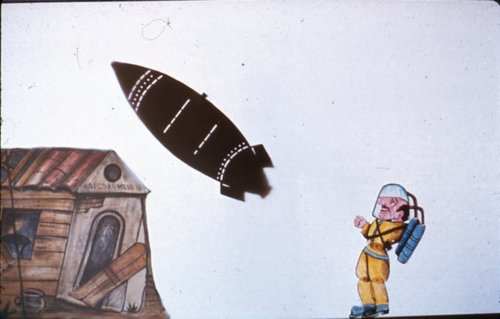I was browsing around Project Gutenberg and stumbled on a book with this magnificent title: The Humbugs of the World. An Account of Humbugs, Delusions, Impositions, Quackeries, Deceits and Deceivers Generally, in all Ages. And it’s by none other than P. T. Barnum.
So I thought, that could be interesting. And one of the things that caught my eye from the contents was ‘The Miscegenation Hoax‘. Barnum explains:
the history of Ancient and Modern Humbugs would not be complete without a record of the last and one of the most successful of known literary hoaxes. This is the pamphlet entitled “Miscegenation,” which advocates the blending of the white and black races upon this continent, as a result not only inevitable from the freeing of the negro, but desirable as a means of creating a more perfect race of men than any now existing. This pamphlet is a clever political quiz; and was written by three young gentlemen of the “World” newspaper, namely. D. G. Croly, George Wakeman, and E. C. Howell.
The design of “Miscegenation” was exceedingly ambitious, and the machinery employed was probably among the most ingenious and audacious ever put into operation to procure the indorsement of absurd theories, and give the subject the widest notoriety. The object was to so make use of the prevailing ideas of the extremists of the Anti-Slavery party, as to induce them accept doctrines which would be obnoxious to the great mass of the community, and which would, of course, be used in the political canvass which was to ensue. It was equally important that the “Democrats” should be made to believe that the pamphlet in question emanated from a “Republican” source.
This is in 1864, during the Civil War, so of course the Republicans are the abolitionist party. It carries on a bit later:
The first stumbling-block was the name “amalgamation,” by which this fraternizing of the races had been always known. It was evident that a book advocating amalgamation would fall still-born, and hence some new and novel word had to be discovered, with the same meaning, but not so objectionable. Such a word was coined by the combination of the Latin miscere, to mix, and genus, race: from these, miscegenation—a mingling of the races. […] Next, it was necessary to give the book an erudite appearance, and arguments from ethnology must form no unimportant part of this matter. Neither of the authors being versed in this science, they were compelled to depend entirely on encyclopedias and books of reference. This obstacle to a New York editor or reporter was not so great as it might seem. The public are often favored in our journals with dissertations upon various abstruse matters by men who are entirely ignorant of what they are writing about. It was said of Cuvier that he could restore the skeleton of an extinct animal if he were only given one of its teeth, and so a competent editor or reporter of a city journal can get up an article of any length on any given subject, if he is only furnished one word or name to start with.
I won’t quote the whole thing, intriguing though it is, but I can’t resist this bit:
Although, of course, the mass of the Republican leaders entirely ignored the book, yet a considerable number of Anti-Slavery men, with more transcendental ideas, were decidedly “sold.” The machinery employed was exceedingly ingenious. Before the book was published, proof-copies were furnished to every prominent abolitionist in the country, and also to prominent spiritual mediums, to ladies known to wear Bloomers, and to all that portion of our population who are supposed to be a little “soft” on the subject of reform.
Apparently spiritual mediums and ladies known to wear bloomers were the 1860s equivalents of latte-drinking tree-hugging Volvo drivers.
Anyway, archive.org has the original pamphlet online: Miscegenation: The Theory of the Blending of the Races, Applied to the American White Man and Negro. It’s hard to recapture the sense of shock apparently provoked at the time, although I suppose even now it would be fairly radical to suggest that we should be actively working to eliminate black and white as distinct entities. In fact far from being shocking, a lot of it is frankly boring, especially all the C19th racial pseudoscience; but it has its moments, like this bit of mischief:
THE SECRET OF SOUTHERN SUCCESS
The North is wondering — the world is wondering — at the marvelous success of the Southern people in statesmanship and war. The discretion, endurance, energy, and heroism they have shown in sustaining for so long a time a rebellion supposed to be feeble and short-lived, have elicited the admiration even of their enemies […] The truth may as well be understood, that the superiority of the slaveholding classes of the South arises from their intimate communication, from birth to death, with the colored race. Like Anteus, sent to his mother earth, they have risen reinvigorated. […]
On this point we might quote many pro and anti-slavery authorities, but the extracts would scarcely be fit for general reading. It is a notorious fact, however, that, for three generations back, the wealthy, educated, governing class of the South have mingled their blood with the enslaved race. These illicit unions, though sanctioned neither by law nor conscience, and which, therefore, are degrading morally, have helped to strengthen the vitality and add to the mental force of the Southerner. The emotional power, fervid oratory and intensity which distinguishes all thoroughbred slaveholders, is due to their intimate association with the most charming and intelligent of their slave girls. The local history of New Orleans, since its occupation by the Union army, proves what has often been suspected, that unions between the slaveholders and their slaves have often had, in the eyes of the parties themselves, all the sanctities of marriage. These facts give us an inkling of some of the sources of Southern power.
If you can ignore, just for a moment, the high stakes of the political issue at hand, and the many decades of overwhelming human misery caused by the slavery and segregation which the pamphlet was surreptitiously supporting… well, you almost have to admire bits of it as an example of proper, old fashioned trolling. These guys would feel right at home on the internet.
AN OMEN.
The statue of Liberty which has just crowned the capitol at Washington, stands as a symbol of the future American of this continent. It was meet and proper that while slavery exercised its baneful sway at the seat of Government, that the great dome of the capitol should have been unfinished, and that the figure of Liberty should not have unveiled its awful form upon the topmost summit. The maker of that statue has “builded better than he knew.” In order to insure it against the storms and variable temperature of a Virginia atmosphere, it has been washed with an acid which has caused a slight oxidation, producing a rich and uniform bronze tint, which no rains can discolor and no sun bleach. When the traveler approaches the city of magnificent distances, the seat of what is destined to be the greatest and most beneficent power on earth, the first object that will strike his eye will be the figure of Liberty surmounting the capitol ; not white, symbolising but one race, nor black typifying another, but a statue representing the composite race, whose sway will extend from the Atlantic to the Pacific ocean, from the Equator to the North Pole—the Miscegens of the Future.
Anyway, I just thought it was a fascinating little historical detour, not least the origin of the word ‘miscegenation’ as a faux-politically correct euphemism for ‘amalgamation’. It’s striking that ‘miscegenation’ is still a very loaded term, while ‘amalgamation’ has, as far as I know, lost any association with racial mixing at all. And also: isn’t it amazing how much stuff you can find on the internet these days.




